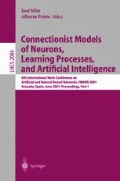Abstract
In this paper we review the lateral Inhibition (LI) as a connectionist conceptual model invariant in front of level translation, moving up from physical to symbol and then to the knowledge level where LI is transformed into a “pattern of reasoning”. Afterwards, we explore the possibilities of this pattern as a component of modelling fault-tolerant cooperative processes. LI can be considered as an adaptive mechanism that integrates excitation and inhibition in a dynamic balance between complementary information sources.
Access this chapter
Tax calculation will be finalised at checkout
Purchases are for personal use only
Preview
Unable to display preview. Download preview PDF.
References
Ratliff, F.: Mach Bands: Quantitative Studies on Neural Networks in the Retinal. Holden-Day, Inc. (1965).
Hartline, K. K., Ratliff, F.: Spatial Summation of Inhibitory Influences in the Eye of Limulus. Science, 120 (1954) 781
Hubel, D. H., Wielse, T. N.: Receptive Fields, Binocular Interaction and Functional Architecture in the Cat’s Visual Cortex. J. Physiol. 160 (1962) 106–154.
Moreno, R., Rubio, E.: A Model of Non-Linear Processing in Cat’s Retina. Biol. Cybernetics 37 (1980) 25–31.
Delgado, A. E. et al: A Neurocybernetic Model of Modal Co-operative Decisión in the Kilmer-McCulloch Space. Kybernetes. Vol. 3 (1989) 48–57.
Mira, J. et al: Cooperative Organization Connectivity Patterns and Receptive Fields in the Visual Pathway: Application to Adaptive Thresholding. In: Mira, J., Sandoval, F. (Eds): From natural to Artificial Neural Computation. LNCS, Vol. 930. Springer-Verlag, Berlin Heidelberg New York (1995) 15–23.
Fernández, M. A. et al.: Local Accumulation of Persistent Activity at Synaptic Level: Application to motion analysis. In: Mira, J., Sandoval, F (eds.): From Natural to Artificial Neural Computation. LNCS, Vol. 930. Springer-Verlag, Berlin Heidelberg New York (1995) 137–143.
Sánchez, E.: Modelos del Cuneatus. PhD Thesis. Univ. de Santiago (2000).
Franceschini, N., Pichou, J. M., Blanes, C.: From Insect Vision to Robot Vision. Phil. Trans. R. Soc. London. B 337 (1992) 283–294.
Mira, J. et al.: Cooperative Processes at the Symbolic Level in Cerebral Dynamics: Reliability and Fault Tolerance. In: Moreno, R., Mira, J. (eds.): Brain Processes, Theories and Models. MIT Press (1996) 244–255.
Braitenberg, V.: Vehicles. Experiments in Synthetic Psych. The MIT Press. Mass (1998).
Author information
Authors and Affiliations
Editor information
Editors and Affiliations
Rights and permissions
Copyright information
© 2001 Springer-Verlag Berlin Heidelberg
About this paper
Cite this paper
Mira, J., Delgado, A.E. (2001). What Can We Compute with Lateral Inhibition Circuits?. In: Mira, J., Prieto, A. (eds) Connectionist Models of Neurons, Learning Processes, and Artificial Intelligence. IWANN 2001. Lecture Notes in Computer Science, vol 2084. Springer, Berlin, Heidelberg. https://doi.org/10.1007/3-540-45720-8_5
Download citation
DOI: https://doi.org/10.1007/3-540-45720-8_5
Published:
Publisher Name: Springer, Berlin, Heidelberg
Print ISBN: 978-3-540-42235-8
Online ISBN: 978-3-540-45720-6
eBook Packages: Springer Book Archive

